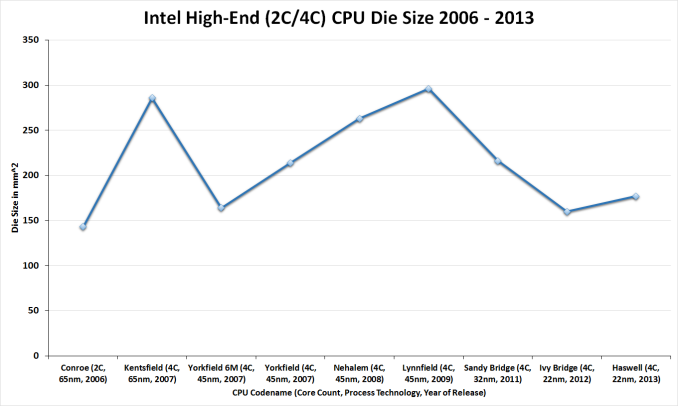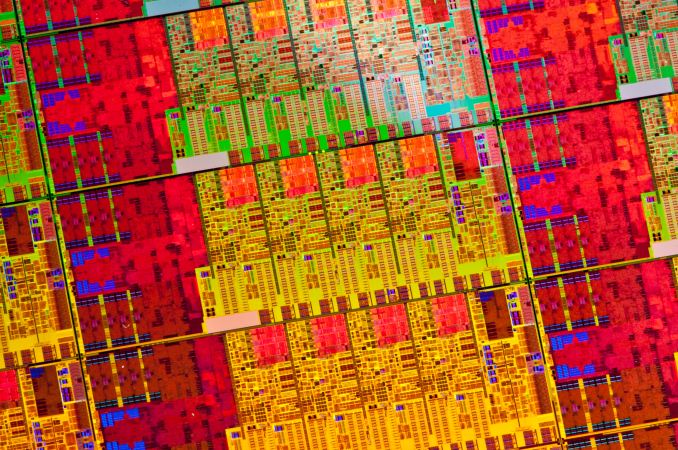The Haswell Review: Intel Core i7-4770K & i5-4670K Tested
by Anand Lal Shimpi on June 1, 2013 10:00 AM ESTDie Size and Transistor Count
Moving on to die sizes and transistor counts, this year Intel is striving to be more straightforward and accurate than was the case with Sandy Bridge and Ivy Bridge. With the Bridge generation we didn’t initially get comparable numbers, only for the correction to throw in additional confusion. For Haswell Intel is laying things out from the start, listing both possible numbers so that either can be compared.
| CPU Specification Comparison | |||||||||
| CPU | Manufacturing Process | Cores | GPU | Transistor Count (Schematic) | Die Size | ||||
| Haswell GT3 4C | 22nm | 4 | GT3 | ? | 264mm2 (est) | ||||
| Haswell GT2 4C | 22nm | 4 | GT2 | 1.4B | 177mm2 | ||||
| Haswell ULT GT3 2C | 22nm | 2 | GT3 | 1.3B | 181mm2 | ||||
| Intel Ivy Bridge 4C | 22nm | 4 | GT2 | 1.2B | 160mm2 | ||||
| Intel Sandy Bridge E 6C | 32nm | 6 | N/A | 2.27B | 435mm2 | ||||
| Intel Sandy Bridge 4C | 32nm | 4 | GT2 | 995M | 216mm2 | ||||
| Intel Lynnfield 4C | 45nm | 4 | N/A | 774M | 296mm2 | ||||
| AMD Trinity 4C | 32nm | 4 | 7660D | 1.303B | 246mm2 | ||||
| AMD Vishera 8C | 32nm | 8 | N/A | 1.2B | 315mm2 | ||||
The two numbers for the most common Haswell configuration, Haswell GT2 4C, are 1.4 billion schematic transistors and 1.6 billion layout transistors. Why and what is the difference? The former count is the number of transistors in the schematic (hence the name), and is generally the number we go by when quoting transistor counts. Meanwhile the second number, the layout number, is the number of transistors used in the fabrication process itself. The difference comes from the fact that while the schematic will use one large transistor – being a logical diagram – production will actually use multiple transistors laid out in parallel for layout and process reasons. So how many transistors does Haswell have? It has both 1.4B and 1.6B, depending on which number we’re after, with 1.4B being the number Intel is passing around.
In any case, even among quad cores Haswell is going to come in a couple of different sizes. Along with the 1.4B transistor, 177mm2 4C/GT2 version of Haswell, there is the 4C/GT3 version of Haswell, which Intel doesn’t list the die size or transistor count for. Based on our rough measurements of the physical die we’re at 264mm2, which including the epoxy covering the die will run a bit large.
Breaking things down to the GPU portion of Haswell, based in turn on these measurements I came up with an 87mm^2 adder for the extra hardware in Haswell GT3 vs. GT2. Doubling that 87mm^2 we get a rough idea of how big the full 40 EU Haswell GPU might be: 174mm^2. If my math is right, this means that in a quad-core Haswell GT3 die, around 65% of the die area is GPU. This is contrary to the ~33% in a quad-core Haswell GT2. I suspect a dual-core + GT3 design is at least half GPU. Meanwhile Crystalwell, the 128MB eDRAM, adds another 84mm2 die (by our measurements) to the entire package.
On a comparative basis, the 4C/GT2 version of Haswell is roughly 200M transistors and 17mm2 bigger than the comparable 4C/GT2 version of Ivy Bridge. The transistor count increase is roughly what we’d expect, with most of those transistors going to Haswell itself while the GPU remains relatively unchanged. Though it’s interesting to note that while this marks a 17% increase in transistors, it’s only an 11% increase in die size. Ivy Bridge was a small die for an Intel, and while Haswell grows larger in exchange for the additional functionality the new architecture provides, it’s still a fairly small GPU and reaches a density greater than Ivy Bridge itself. Or to put this another way, Intel’s last tock CPU, Sandy Bridge, was larger still by almost 40mm2. It’s only once we start adding the relatively big GT3 GPU, and not the CPU, that we see Intel go well above 200mm2.












210 Comments
View All Comments
AmdInside - Sunday, June 2, 2013 - link
I am actually more interested in the new 8 series chipsets than Haswell. I have a Sandybridge work desktop and Ivybridge gaming desktop and would switch my Sandybridge motherboard if the chipset were backwards compatible with SB CPUs.Klimax - Sunday, June 2, 2013 - link
Just reminder: We are more or less out of free performance without new algorithms or massive complexity/power consumption. (There are limits to what we can do)And Intel engineers won't increase complexity of chips. (Otherwise they'd have their own version of GPU problems)
Anyway, waiting for Haswell-E... (Could use AVX2, but don't wont to lose 6 cores of 3930k)
ashetosvlakas - Sunday, June 2, 2013 - link
"As we’ve seen in the past, the K-series parts (and now the R-series as well) omit support for vPro, TXT, VT-d, and SIPP from the list."As this is the official Haswell review and since TSX are not included in the K-series parts, I believe this is a huge omission from the review, especially since transactional memory is a revolutionary technology with a lot of potential. I find the lack of mention misleading and it should be corrected as soon as possible.
KAlmquist - Sunday, June 2, 2013 - link
Thanks for letting us know this. Checking the specifications on ark.intel.com, I find:i5-4430 no TSX
i5-4570 has TSX
i5-4670 has TSX
i5-4670K no TSX
i7-4770 has TSX
i7-4770K no TSX
So TSX is missing from half of the current Haswell models (ignoring the low power S and T chips). So far we only have quad core chips; I expect that TSX will be missing from most of the dual core chips. It doesn't seem that TSX is intended to be used by developers writing general purpose code.
Kougar - Sunday, June 2, 2013 - link
Is 2016 the earliest we will see Haswell-E launch?Buying a 4770K means I'm wasting 33% of the die on a GPU I don't want, and because it's a "K" chip it will also lose VT-d capability. Six-core "K" chips retain VT-d support, but buying SB-E seems silly given Haswell offers much better IPC and single-threaded performance, and later even against IB-E it would feel like paying more for less.
Intel has taken a perpetual 2-year break between updating its high end, so if IB-E launches Q4'13 then it seems Q4'15 would be the earliest Haswell-E will show up?
Charlesm1950 - Sunday, June 2, 2013 - link
Haswell GT3e graphics come at what price? Certainly a lot more than Haswell GT2 or Richland A10 graphics. And Intel is right, Haswell GT3e graphics beats old, entry level discrete graphics cards. BUT, Haswell does not do DUAL GRAPHICS! Pair a Haswell with a dGPU and you get only the graphics horsepower of the dGPU. In short, you waste all that die area that Intel devoted to GT3e and eDRAM. On the other hand, pair a AMD Richland A10 with a dGPU and both GPUs work in tandem to give performance scores well beyond Haswell GT3e and for dare I say a lot less money. That's true even with the cheapest entry level Radeon GPU. So, Intel has created a monster graphics engine and put memory on the die - but to claim its free or the best solution is just being a fan boy for Intel.monohouse - Sunday, June 2, 2013 - link
this my friends, is a joke, the mighty Haswell K models will not support VT-x, LOL this is going to be the first nail in Intel's coffin in favor of AMD, and I bet AMD are going to take advantage of this (and they already take advantage of Intel's "K" marketing strategy - why buy an incredibly expensive Intel "K" model without VT-x support, when you can buy an AMD both unlocked and with VT-x support) (the joke is that a 5-year old Core 2 Duo has more to offer than the latest and greatest Intel parts [it supports VT-x]). I am running a 4300 mhz Wolfdale (Penryn) and an another 3000 mhz Conroe, none of what I see here (and in part due to the lack of VT-x support) from Haswell is of any significant enough value over my current hardware, I would have considered it if I had a Pentium 4, but even then I would rather go to the AMD side, since they present no obstacles.and I still have many functional PCI cards and I am not about to throw them away just because Intel decided not to support them (yet another nail in Intel's coffin) (in my opinion hardware has to comply with the user's wishes, not the other way around).
skrewler2 - Monday, June 3, 2013 - link
Wait, what? The K series doesn't include VT-d support, I don't see anything saying they don't support VT-x.BillyONeal - Monday, June 3, 2013 - link
Your comment doesn't make sense. AMD chips obviously don't have VT-x support; they have a competing standard, AMD-V. The first generation of virtualization extensions didn't make much of a dent in perf. The larger gains came as a result of SLAT which both AMD and Intel added around the Nehalem timeframe.monohouse - Sunday, June 23, 2013 - link
but SLAT is not going to be available on K models because virtualization is disabled ?